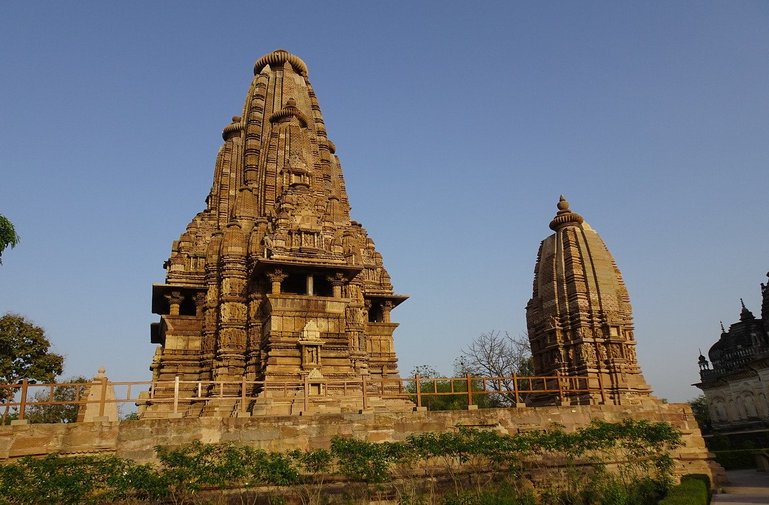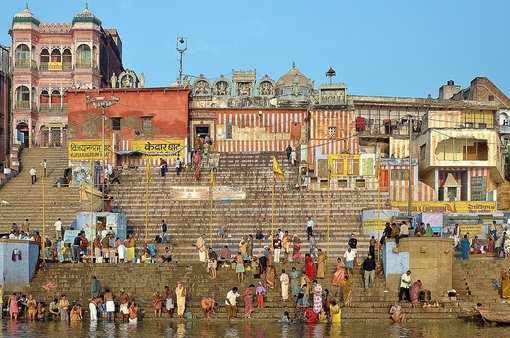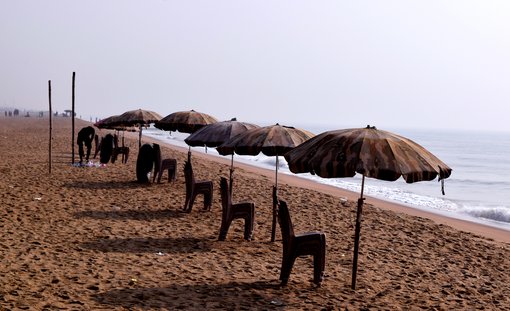The 12 Jyotirlingas are sacred abodes of Lord Shiva spread across India, revered for their spiritual significance and divine presence. Each shrine holds unique mythological tales and draws millions of devotees seeking blessings and spiritual enlightenment. These ancient sites symbolize the cosmic energy and eternal power of Lord Shiva in Hindu mythology.

Kashi Vishwanath Temple, Varanasi, Uttar Pradesh
1. Somnath Jyotirlinga
Location: Prabhas Patan, Gujarat
Legend and Significance: Somnath, meaning "Lord of the Moon," is believed to be the first among the twelve Jyotirlingas. According to legend, it was originally built by the moon god, Som, in gold as an offering to Lord Shiva to rid himself of a curse. Over millennia, the temple has been destroyed and rebuilt several times due to invasions and natural disasters, symbolizing resilience and devotion in the face of adversity.
Architecture and Features: The current temple, constructed in the Chalukya style of architecture, stands as a symbol of cultural and religious heritage. Its imposing structure and intricate carvings draw devotees and tourists alike. The temple complex includes various smaller shrines dedicated to other deities, reflecting a blend of Hindu spiritual traditions.
Pilgrimage Experience: Devotees visit Somnath to seek blessings and witness the powerful presence of Lord Shiva. The temple is particularly revered during the Maha Shivaratri festival, attracting millions who come to offer prayers and witness elaborate rituals and processions. The serene setting by the Arabian Sea adds to the spiritual experience, making Somnath a must-visit destination for spiritual seekers and history enthusiasts alike.
2. Mallikarjuna Jyotirlinga
Location: Srisailam, Andhra Pradesh
Legend and Significance: Mallikarjuna Jyotirlinga is located on the sacred Shri Shaila Mountain, where Lord Shiva is worshipped as Mallikarjuna and Goddess Parvati as Bhramaramba. The temple's origin is rooted in Hindu mythology, where it is believed that Lord Shiva assumed the form of a Jyotirlinga to settle a dispute between Brahma and Vishnu.
Architecture and Features: The temple architecture showcases a blend of Dravidian and Rajasthani styles, with intricate carvings and sculptures adorning its walls and pillars. The sacredness of the site is enhanced by its location amidst the lush Nallamala forests, offering a serene and spiritual atmosphere for devotees.
Pilgrimage Experience: Pilgrims undertake a rigorous journey to reach Srisailam, often trekking through the forested hills to reach the temple. The spiritual ambiance of Mallikarjuna Jyotirlinga, coupled with the natural beauty of its surroundings, makes it a significant pilgrimage site in southern India. The annual festival of Maha Shivaratri is celebrated with great fervor, attracting devotees who come to seek the blessings of Lord Shiva and experience the divine presence at this sacred site.
3. Mahakaleshwar Jyotirlinga
Location: Ujjain, Madhya Pradesh
Legend and Significance: Mahakaleshwar Jyotirlinga is one of the most revered shrines dedicated to Lord Shiva. Legend has it that a demon named Dushana wreaked havoc upon Ujjain, and upon the prayer of the citizens, Lord Shiva appeared as Mahakaleshwar and vanquished the demon, subsequently residing in the form of a Jyotirlinga.
Architecture and Features: The temple architecture reflects the Maratha style, characterized by its grand entrance, intricately carved pillars, and a towering spire. The inner sanctum houses the Jyotirlinga, which is unique as it faces south, unlike most other Shiva temples that face east.
Pilgrimage Experience: Mahakaleshwar attracts devotees from across the country, especially during the festival of Mahashivaratri, when the temple comes alive with devotional fervor and elaborate rituals. The temple's location on the banks of the Shipra River adds to its spiritual allure, providing a tranquil setting for introspection and worship.
4. Omkareshwar Jyotirlinga
Location: Omkareshwar, Madhya Pradesh
Legend and Significance: Omkareshwar Jyotirlinga is situated on an island called Mandhata in the Narmada River. The island's shape resembles the symbol "Om," which holds significant spiritual importance in Hinduism. According to mythology, Vindhya, a mountain range, worshipped Lord Shiva on this island, and hence the Jyotirlinga manifested here.
Architecture and Features: The temple architecture combines North Indian and South Indian styles, reflecting the cultural amalgamation prevalent in central India. The temple complex includes several smaller shrines dedicated to various deities, creating a spiritual hub for devotees and pilgrims.
Pilgrimage Experience: Devotees undertake a journey to Omkareshwar to seek blessings and spiritual solace. The island's serene ambiance amidst the flowing Narmada River enhances the pilgrimage experience, offering devotees an opportunity for introspection and divine communion. The annual festival of Kartik Purnima is celebrated with great enthusiasm, attracting pilgrims who participate in religious rituals and cultural events.
5. Kedarnath Jyotirlinga
Location: Kedarnath, Uttarakhand
Legend and Significance: Kedarnath Jyotirlinga is nestled in the Garhwal Himalayas, near the Mandakini River. According to legend, after the battle of Kurukshetra, the Pandavas sought forgiveness from Lord Shiva for their sins. However, Lord Shiva evaded them repeatedly and hid in the form of a bull at Kedarnath. Eventually, Lord Shiva appeared as a Jyotirlinga and blessed the Pandavas.
Architecture and Features: The temple architecture follows the traditional Himalayan style, characterized by its stone construction and pyramid-like structure. The temple is surrounded by snow-capped peaks, adding to its spiritual charm and natural beauty.
Pilgrimage Experience: Kedarnath is considered one of the holiest pilgrimage sites in Hinduism, attracting devotees and spiritual seekers throughout the year. Pilgrims undertake a challenging trek through rugged terrain to reach the temple, which is closed during the winter months due to heavy snowfall. The annual opening and closing ceremonies mark the beginning and end of the pilgrimage season, drawing devotees who brave the elements to seek the blessings of Lord Shiva.
6. Bhimashankar Jyotirlinga
Location: Pune, Maharashtra
Legend and Significance: Bhimashankar Jyotirlinga is located in the Sahyadri range of Maharashtra, amidst dense forests and wildlife sanctuaries. Legend has it that the demon Bhima, after being vanquished by Lord Shiva, requested a place where he could worship him. Pleased with his devotion, Lord Shiva manifested as Bhimashankar Jyotirlinga.
Architecture and Features: The temple architecture is characterized by its simple yet elegant design, typical of Maharashtra's traditional temple architecture. The serene surroundings of Bhimashankar, with its lush greenery and cool climate, create a tranquil atmosphere for devotees.
Pilgrimage Experience: Devotees visit Bhimashankar to seek blessings and witness the divine presence of Lord Shiva. The temple's location in the Western Ghats offers breathtaking views and an opportunity for spiritual rejuvenation amidst nature. The annual festival of Maha Shivaratri is celebrated with enthusiasm, attracting devotees who participate in religious rituals and cultural festivities.
7. Kashi Vishwanath Jyotirlinga
Location: Varanasi, Uttar Pradesh
Legend and Significance: Kashi Vishwanath Jyotirlinga is located in the holy city of Varanasi, on the banks of the sacred Ganges River. Varanasi, also known as Kashi, is believed to be the oldest living city in the world and holds immense spiritual significance in Hinduism. The Jyotirlinga is believed to be the center of the universe and a place where devotees can attain liberation (moksha).
Architecture and Features: The temple complex is a symbol of religious fervor and architectural grandeur, with its gold-plated spire and intricate designs. The sanctum sanctorum houses the Jyotirlinga, which is revered as a powerful symbol of Lord Shiva's presence.
Pilgrimage Experience: Varanasi attracts millions of pilgrims and tourists annually, who come to immerse themselves in the city's spiritual aura and witness its cultural richness. The Ghats of Varanasi, where devotees perform rituals and ceremonies, offer a unique blend of spirituality and serenity. The daily rituals at Kashi Vishwanath Temple, coupled with the mesmerizing Ganga Aarti (river worship ceremony), create an unforgettable pilgrimage experience for visitors.
8. Trimbakeshwar Jyotirlinga
Location: Nashik, Maharashtra
Legend and Significance: Trimbakeshwar Jyotirlinga is situated at the source of the Godavari River in the Brahmagiri mountain range. According to legend, Gautama Rishi, who was suffering from a curse, prayed to Lord Shiva, who manifested as Trimbakeshwar and released the Ganga River from his matted locks to purify the Rishi.
Architecture and Features: The temple architecture reflects the traditional Hemadpanthi style, characterized by its black stone spire and intricate carvings. The temple complex includes various smaller shrines dedicated to other deities, creating a spiritual hub for devotees.
Pilgrimage Experience: Trimbakeshwar attracts pilgrims and tourists alike, drawn by its religious significance and natural beauty. The temple's location amidst lush greenery and the Godavari River enhances the spiritual experience, providing a serene atmosphere for devotees seeking spiritual solace. The temple precincts bustle with activity during festivals like Mahashivaratri, when devotees throng to participate in rituals and seek blessings from Trimbakeshwar Jyotirlinga.
9. Vaidyanath Jyotirlinga
Location: Deoghar, Jharkhand
Legend and Significance: Vaidyanath Jyotirlinga, also known as Baba Baidyanath Dham, is located in the town of Deoghar, amidst the forested hills of Jharkhand. Legend has it that Ravana, the demon king of Lanka, worshipped Lord Shiva here and offered his ten heads as a sacrifice. Impressed by his devotion, Lord Shiva granted him immortality and the boon of invincibility.
Architecture and Features: The temple architecture reflects a blend of traditional North Indian and Bengal styles, with its ornate carvings and sculpted pillars. The main shrine houses the Jyotirlinga, which is adorned with silver and gold ornaments during special occasions and festivals.
Pilgrimage Experience: Vaidyanath Dham attracts devotees seeking healing and spiritual rejuvenation. The temple is visited by thousands of pilgrims during the holy month of Shravana and the annual festival of Shravani Mela, where devotees undertake a rigorous pilgrimage known as Kanwar Yatra. The serene surroundings of Deoghar, coupled with the temple's spiritual ambiance, create an atmosphere conducive to prayer and introspection.
10. Nageshwar Jyotirlinga
Location: Dwarka, Gujarat
Legend and Significance: Nageshwar Jyotirlinga is situated near the town of Dwarka, along the coast of Gujarat. According to mythology, a demon named Daruka tormented devotees who worshipped Lord Shiva. To protect them, Lord Shiva manifested as Nageshwar Jyotirlinga and vanquished the demon, thus earning the title of "Darukavana Nashaka" (destroyer of Daruka's forest).
Architecture and Features: The temple architecture is modern yet retains traditional elements, with a towering shikara (spire) and intricate sculptures depicting various mythological themes. The sanctum sanctorum houses the Jyotirlinga, which is revered for its healing powers and spiritual significance.
Pilgrimage Experience: Devotees visit Nageshwar Jyotirlinga to seek blessings for protection and well-being. The temple's location near the Arabian Sea offers breathtaking views and a tranquil ambiance for prayer and meditation. The annual festival of Maha Shivaratri is celebrated with enthusiasm, drawing devotees who participate in religious rituals and cultural festivities.
11. Rameshwar Jyotirlinga
Location: Rameswaram, Tamil Nadu
Legend and Significance: Rameshwar Jyotirlinga is located on the island of Rameswaram, off the coast of Tamil Nadu. According to legend, Lord Rama worshipped Lord Shiva here to seek forgiveness for killing Ravana, a Brahmin, during the battle of Lanka. Lord Shiva appeared as a Jyotirlinga and blessed Lord Rama, earning the name Rameshwar (Lord of Rama).
Architecture and Features: The temple architecture is characterized by its Dravidian style, with towering gopurams (gateway towers) adorned with colorful sculptures and carvings depicting scenes from Hindu mythology. The temple complex includes several smaller shrines dedicated to other deities, creating a vibrant spiritual atmosphere.
Pilgrimage Experience: Rameswaram is considered one of the holiest pilgrimage sites in India, attracting devotees who come to bathe in the sacred waters of the Agni Theertham and offer prayers at the Rameshwar Jyotirlinga. The temple's association with the Ramayana epic and its serene coastal setting make it a place of profound spiritual significance and cultural heritage.
12. Grishneshwar Jyotirlinga
Location: Ellora, Maharashtra
Legend and Significance: Grishneshwar Jyotirlinga is situated near the Ellora Caves, a UNESCO World Heritage site renowned for its rock-cut cave temples. Legend has it that a devout woman named Kusuma worshipped Lord Shiva with utmost devotion and built the temple. Pleased with her devotion, Lord Shiva manifested as Grishneshwar Jyotirlinga and granted her a boon.
Architecture and Features: The temple architecture reflects the medieval Maratha style, with its intricately carved walls and domed shikara. The sanctum sanctorum houses the Jyotirlinga, which is revered for its sanctity and spiritual potency.
Pilgrimage Experience: Grishneshwar attracts pilgrims and tourists who visit the Ellora Caves, exploring the rich cultural and architectural heritage of Maharashtra. The temple's serene surroundings amidst the Sahyadri mountain ranges offer a tranquil setting for spiritual introspection and devotion. The annual festival of Mahashivaratri is celebrated with fervor, drawing devotees who participate in religious rituals and cultural performances.
Each of these twelve Jyotirlingas holds profound spiritual significance and attracts millions of devotees seeking blessings and spiritual enlightenment. Visiting these sacred shrines is not just a religious journey but also an exploration of India's rich cultural heritage and architectural marvels.




